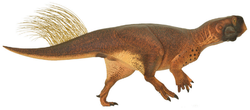| Navajoceratops Temporal range: Late Cretaceous, ~ | |
|---|---|
 | |
| Holotype parietals from the front and back | |
| Scientific classification | |
| Kingdom: | Animalia |
| Phylum: | Chordata |
| Class: | Reptilia |
| Clade: | Dinosauria |
| Clade: | † Ornithischia |
| Clade: | † Ceratopsia |
| Family: | † Ceratopsidae |
| Subfamily: | † Chasmosaurinae |
| Genus: | † Navajoceratops Fowler and Freedman Fowler, 2020 |
| Type species | |
| †Navajoceratops sullivani Fowler and Freedman Fowler, 2020 | |
Navajoceratops (meaning "Navajo horned face") is a genus of ceratopsid dinosaur from the late Cretaceous Period of what is now North America. The genus contains a single species, N. sullivani, named after Robert M. Sullivan, leader of the expeditions that recovered the holotype. [1]

The holotype specimen, SMP VP-1500, collected in 2002, consists of a partial skull. It was discovered in the Campanian Hunter Wash Member of the Kirtland Formation, New Mexico. [1] It was informally named in 2016. [2]
Navajoceratops was a member of the Chasmosaurinae. Alongside fellow chasmosaurine Terminocavus , also from the Kirtland Formation and described in the same paper, Navajoceratops was found to represent a stratigraphic and morphological intermediate between Pentaceratops and Anchiceratops . Navajoceratops was also found to be marginally less derived than Terminocavus. [1]



